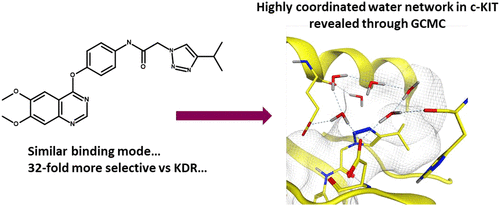当前位置:
X-MOL 学术
›
ACS Med. Chem. Lett.
›
论文详情
Our official English website, www.x-mol.net, welcomes your
feedback! (Note: you will need to create a separate account there.)
Utilizing Grand Canonical Monte Carlo Methods in Drug Discovery.
ACS Medicinal Chemistry Letters ( IF 3.5 ) Pub Date : 2019-12-11 , DOI: 10.1021/acsmedchemlett.9b00499 Michael S Bodnarchuk 1 , Martin J Packer 1 , Alexe Haywood 1
ACS Medicinal Chemistry Letters ( IF 3.5 ) Pub Date : 2019-12-11 , DOI: 10.1021/acsmedchemlett.9b00499 Michael S Bodnarchuk 1 , Martin J Packer 1 , Alexe Haywood 1
Affiliation

|
The concepts behind targeting waters for potency and selectivity gains have been well documented and explored, although maximizing such potential gains can prove to be challenging. This problem is exacerbated in cases where there are multiple interacting waters, wherein perturbation of one water can affect the free energy landscape of the remaining waters. Knowing the right modification a priori is challenging, and computational approaches are ideally suited to help answer the key question of which substitution is best to try. Here, we use Grand Canonical Monte Carlo and the recent Grand Canonical Alchemical Perturbation methods to both understand and predict the effect of ligand-mediated water displacement when more than one water molecule is involved, as well as to understand how exploiting water networks can help govern selectivity.
中文翻译:

在药物发现中使用大正则蒙特卡罗方法。
尽管有力地证明了将此类潜在收益最大化的可能性,但针对水的效价和选择性增益的概念已得到了充分的文献记载和探讨。在存在多个相互作用的水的情况下,这个问题会更加严重,其中一种水的扰动会影响其余水的自由能态势。先验地知道正确的修改是具有挑战性的,并且计算方法理想地适合于帮助回答哪个替代是最佳尝试的关键问题。在这里,我们使用大正则蒙特卡罗方法和最近的大正则炼金术微扰方法来理解和预测当涉及多个水分子时配体介导的水驱替作用,以及了解如何利用水网络来帮助治理选择性。
更新日期:2019-12-21
中文翻译:

在药物发现中使用大正则蒙特卡罗方法。
尽管有力地证明了将此类潜在收益最大化的可能性,但针对水的效价和选择性增益的概念已得到了充分的文献记载和探讨。在存在多个相互作用的水的情况下,这个问题会更加严重,其中一种水的扰动会影响其余水的自由能态势。先验地知道正确的修改是具有挑战性的,并且计算方法理想地适合于帮助回答哪个替代是最佳尝试的关键问题。在这里,我们使用大正则蒙特卡罗方法和最近的大正则炼金术微扰方法来理解和预测当涉及多个水分子时配体介导的水驱替作用,以及了解如何利用水网络来帮助治理选择性。











































 京公网安备 11010802027423号
京公网安备 11010802027423号